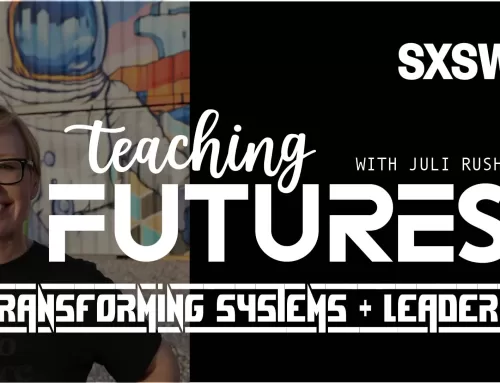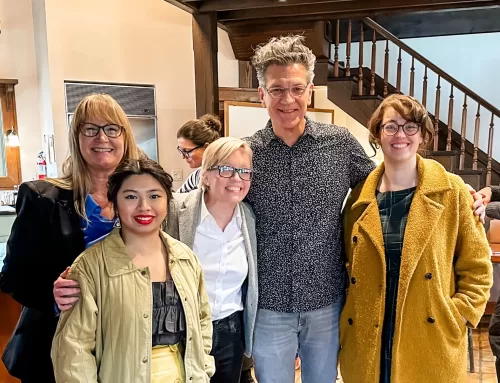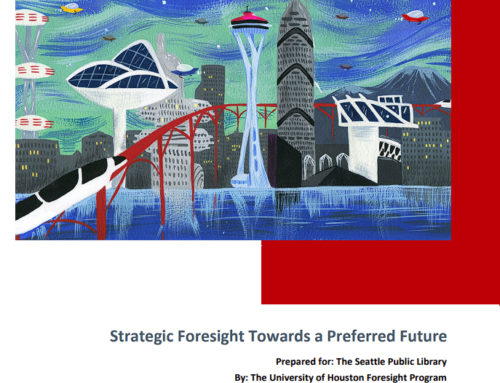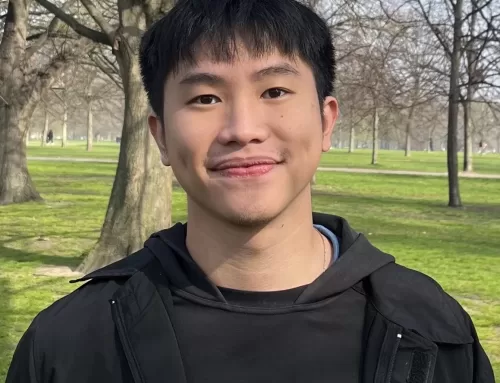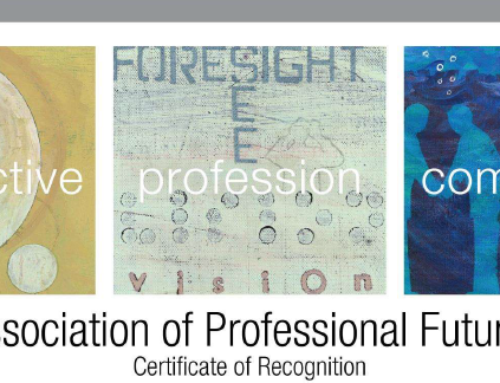In the Foresight ProSeminar class, students wrote a description of the foresight field for non-futurists suitable for publication in a mainstream newspaper or magazine. Here’s the second part to one student’s submission.
Contributor: Tom Rau
Part 1 of this series was about accepting the role of chance in our lives and in our work; that making the most optimal decision possible does not guarantee our desired results. Chance, probability, and uncertainty are huge players in this game we call life and we need to account for them early and often in our decision making processes and in conversations with our clients. In part two we are going to dissect that idea, apply it to the concept of multiple futures, and show how our decision making and actions can ultimately affect the probability of our desired outcome and help us achieve preferred futures.
 The Foundation – Expected Value (EV)
The Foundation – Expected Value (EV)
Let me start this piece with a small apology. We do have to do a little bit of math. But understanding the equity math is key to understanding how we can apply levels of uncertainty quantitatively to our decision making. And I promise it’s not that painful. For me, when I was a poker player, understanding how to apply this concept was a game changer. And I use it all the time to help me assess tough decisions.
We are going to start with the simplest equity problem, a coin flip and then we will move onto the dynamics of a poker hand. Pretend we want to bet on the outcome of a series of coin flips and we each agreed to wager a $1 on the outcome. Our expected return is $0 on each flip. Yes we may win 70 of the 100 times we flip, but over time it should be a 50/50 proposition. On half of the flips we would win a $1 and on half the we would lose a dollar. Thus our expected value or EV for each flip is 0. Yes, it’s really obvious, but it’s also a great place to get familiar with expected value math. This is how we calculate our expected return or expected value of each flip.
Expected Value = (Win percentage X amount won) – (win percentage X amount lost)
EV per coin flip = (50%* $1 ) – (50% * $ 1)
EV per coin flip = $0
So we can see now that our expected return on each coin flip is $0. But let’s change it up and make it a deal too good to pass on. We still put in a $1 each time but now our opponent is wagering $10 vs our $1. Thus:
EV per flip = (50%* $10 ) – (50% * $ 1)
EV per coin flip= $4.50
Another way to look at it is this. If we did this flip 100 times and know that we are going to win on average 50 times then we would win ten dollars fifty times for a profit of five hundred dollars on our wins and then we would lose fifty times for a loss of fifty dollars on our losses. Now out of one hundred total flips we come away with four hundred fifty dollars, or $4.50 per flip. That $4.50 is our EV (expected value).
So while the first article in the series was about really accepting that ultimate finality isn’t something we have control over and more so why results oriented thinking is a really short sighted path to nowhere. This article is expands on that by forcing us to think about our decisions through the lens of our expected value. And as futurists and foresight professionals we need to be thinking about how our decisions should be increasing the EV of the decisions of the clients and organizations we work with. Let’s apply these same concepts to something that is a great model for futures and multiple futures. Poker.
Poker & Multiple Futures
In Texas Hold’em we start every hand only knowing our own starting hand. We do not know exactly what our opponents have, and we don’t yet know the flop, the turn or the river. They represent the future. What lays between us and what happens after the river card is a near endless possible number of outcomes. In fact there are 51,979,200 different flop, turn, river combinations possible and that’s just the beginning of how to calculate how a hand may play out. Each of those millions of outcomes represents a different future. This parallels the concept of multiple futures in the foresight world. And just like in futures the further out we look in the hand the more potential outcomes there are out there lurking in the shadows.
The key takeaway is this, in poker one of the ways we represent the uncertainty of our opponents hand is by using hand ranges. This is akin to the futurist creed, “we do not predict the future.” In poker we say, we can never put an opponent on a single hand, we can only put them on a range of hands. And just like with the future by studying our opponents, their trends, their drivers, their motives, etc, we begin to know how they play different strength hands in different scenarios. We learn how and when they play when they are bluffing, when they have over pairs, sets, draws, flushes, etc. From there we take the one hand we do know, our own, and see what our win percentage is against all of the combinations of hands we think our opponent may have. Then once we put it all together we are back to the EV (expected value) math from the coin flip example; that is two variables, a win percentage and an amount won or lost. So if we decide there are 5 plausible futures, we can estimate the likelihoods for each and the risk/reward for each and start to build much more sound strategies for different scenarios.
The more data we have about a domain, about trends, and drivers, etc the more we can narrow down the range of potential, probable, and plausible outcomes we have and the easier time we have making decisions and creating strategies that have closer to an optimal expected value. The math can get about as deep as we want it to but ultimately it all comes down to correctly assessing two variables, win percentage and amount won/lost. And If we can estimate those variables at different time horizons and for different scenarios we can really start to build some cool and interesting dynamic models for our clients that change as trends change.
Preferred Futures
Imagine we are playing a game of poker and we have the worst possible hand at the river. We know it has a zero percent chance of winning the hand at showdown. We know that we have zero actual equity in the pot. Our opponent might have a hand that they think is decent that has a 40% chance of winning so in theory they should be able to call a small bet and have positive expected value. Keep in mind though that they don’t know that we have the worst possible hand and no chance of winning at showdown so they actually have 100% equity in the pot. Knowing all of this it would be wise for us to make a large bet because if we know they are going to fold a decent percentage of the time our bluff has a positive return. We have now created equity for a hand that should have had none. I like to think of preferred futures as not only the future that we want, but the act of creating additional equity and increasing the probability of that future coming to exist.
Because just like in poker, by collecting and synthesizing the right information we can create agency and equity in our own future. Knowing where systems are weak or strong and knowing where new patterns and trends are emerging we begin to see where we can create additional opportunities and ameliorate our biggest risks. And just like in poker, we have to simultaneously accept the way things are and are currently heading while at the same time accepting that we can be the agents of the change we want to see. Every poker hand is a chance to tell a story. For it to be successful it has to be authentic and fit within the context of the hand. In foresight, we work for clients and organizations whose missions and visions also have to be authentic and fit within the context of an always changing world. And If we are constantly aware of how we want to fit into all of the futures that may occur we will be able to seize upon opportunities as they arise and create additional equity in our most preferred futures.
One Key Difference
At the end of the day that’s why I love foresight and futures work. Like poker, it’s full of infinite possibilities and endless opportunities to learn, be curious, and make really good bets. But unlike poker, it’s not a zero sum game. Because in poker if we are winning, someone else is losing. It’s extremely predatory in nature. But in the real world we do not have to play a zero sum game. We actually have the opportunity to create a world with far more winners than losers. We just have to apply foresight, accept change, and accept chance. In doing so we will have learned the right way to gamble.
About the Author

Follow Tom Rau at
https://www.linkedin.com/in/tom-rau/
